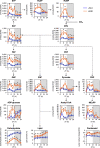Enhancing carbohydrate repartitioning into lipid and carotenoid by disruption of microalgae starch debranching enzyme
- PMID: 33837247
- PMCID: PMC8035404
- DOI: 10.1038/s42003-021-01976-8
Enhancing carbohydrate repartitioning into lipid and carotenoid by disruption of microalgae starch debranching enzyme
Abstract
Light/dark cycling is an inherent condition of outdoor microalgae cultivation, but is often unfavorable for lipid accumulation. This study aims to identify promising targets for metabolic engineering of improved lipid accumulation under outdoor conditions. Consequently, the lipid-rich mutant Chlamydomonas sp. KOR1 was developed through light/dark-conditioned screening. During dark periods with depressed CO2 fixation, KOR1 shows rapid carbohydrate degradation together with increased lipid and carotenoid contents. KOR1 was subsequently characterized with extensive mutation of the ISA1 gene encoding a starch debranching enzyme (DBE). Dynamic time-course profiling and metabolomics reveal dramatic changes in KOR1 metabolism throughout light/dark cycles. During light periods, increased flux from CO2 through glycolytic intermediates is directly observed to accompany enhanced formation of small starch-like particles, which are then efficiently repartitioned in the next dark cycle. This study demonstrates that disruption of DBE can improve biofuel production under light/dark conditions, through accelerated carbohydrate repartitioning into lipid and carotenoid.
Conflict of interest statement
The authors declare no competing interests.
Figures







Similar articles
-
Light/dark cycling causes delayed lipid accumulation and increased photoperiod-based biomass yield by altering metabolic flux in oleaginous Chlamydomonas sp.Biotechnol Biofuels. 2019 Feb 21;12:39. doi: 10.1186/s13068-019-1380-4. eCollection 2019. Biotechnol Biofuels. 2019. PMID: 30828384 Free PMC article.
-
Dynamic metabolic profiling together with transcription analysis reveals salinity-induced starch-to-lipid biosynthesis in alga Chlamydomonas sp. JSC4.Sci Rep. 2017 Apr 4;7:45471. doi: 10.1038/srep45471. Sci Rep. 2017. PMID: 28374798 Free PMC article.
-
Metabolic and photosynthetic consequences of blocking starch biosynthesis in the green alga Chlamydomonas reinhardtii sta6 mutant.Plant J. 2015 Mar;81(6):947-60. doi: 10.1111/tpj.12783. Plant J. 2015. PMID: 25645872
-
Storage of starch and lipids in microalgae: Biosynthesis and manipulation by nutrients.Bioresour Technol. 2019 Nov;291:121894. doi: 10.1016/j.biortech.2019.121894. Epub 2019 Jul 25. Bioresour Technol. 2019. PMID: 31387839 Review.
-
Production of carotenoids by microalgae: achievements and challenges.Photosynth Res. 2015 Sep;125(3):423-36. doi: 10.1007/s11120-015-0149-2. Epub 2015 Apr 29. Photosynth Res. 2015. PMID: 25921207 Review.
Cited by
-
Cultivation of microalgae-bacteria consortium by waste gas-waste water to achieve CO2 fixation, wastewater purification and bioproducts production.Biotechnol Biofuels Bioprod. 2024 Feb 15;17(1):26. doi: 10.1186/s13068-023-02409-w. Biotechnol Biofuels Bioprod. 2024. PMID: 38360745 Free PMC article. Review.
-
L-Lactate treatment by photosynthetic cyanobacteria expressing heterogeneous L-lactate dehydrogenase.Sci Rep. 2023 May 4;13(1):7249. doi: 10.1038/s41598-023-34289-3. Sci Rep. 2023. PMID: 37142758 Free PMC article.
-
FLOURY ENDOSPERM 6 mutations enhance the sugary phenotype caused by the loss of ISOAMYLASE1 in barley.Theor Appl Genet. 2023 Apr 3;136(4):94. doi: 10.1007/s00122-023-04339-5. Theor Appl Genet. 2023. PMID: 37010621 Free PMC article.
-
Genetic Engineering of Microalgae for Secondary Metabolite Production: Recent Developments, Challenges, and Future Prospects.Front Bioeng Biotechnol. 2022 Mar 23;10:836056. doi: 10.3389/fbioe.2022.836056. eCollection 2022. Front Bioeng Biotechnol. 2022. PMID: 35402414 Free PMC article. Review.
-
Recent advances in lycopene and germacrene a biosynthesis and their role as antineoplastic drugs.World J Microbiol Biotechnol. 2024 Jun 25;40(8):254. doi: 10.1007/s11274-024-04057-0. World J Microbiol Biotechnol. 2024. PMID: 38916754 Review.
References
-
- Ran W, et al. Storage of starch and lipids in microalgae: biosynthesis and manipulation by nutrients. Bioresour. Technol. 2019;291:121894. - PubMed
-
- Georgianna DR, Mayfield SP. Exploiting diversity and synthetic biology for the production of algal biofuels. Nature. 2012;488:329–335. - PubMed
-
- Park S, Nguyen THT, Jin E. Improving lipid production by strain development in microalgae: strategies, challenges and perspectives. Bioresour. Technol. 2019;292:121953. - PubMed
Publication types
MeSH terms
Substances
LinkOut - more resources
Full Text Sources
Other Literature Sources

